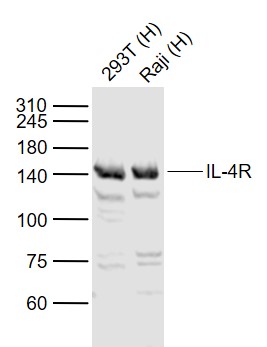
Rabbit Anti-IL-4R antibody
CD124; IL 4R alpha; IL-4 receptor subunit alpha; IL-4-binding protein; IL-4R subunit alpha; IL-4R-alpha; IL-4RA; IL4-BP; Il4r; IL4R nirs variant 1; IL4RA; IL4RA_HUMAN; Interleukin 4 receptor alpha chain; Interleukin 4 receptor; sIL4Ralpha/prot; Soluble IL
View History [Clear]
Details
Product Name IL-4R Chinese Name 白细胞介素4受体抗体 Alias CD124; IL 4R alpha; IL-4 receptor subunit alpha; IL-4-binding protein; IL-4R subunit alpha; IL-4R-alpha; IL-4RA; IL4-BP; Il4r; IL4R nirs variant 1; IL4RA; IL4RA_HUMAN; Interleukin 4 receptor alpha chain; Interleukin 4 receptor; sIL4Ralpha/prot; Soluble IL-4 receptor subunit alpha; Soluble IL-4R-alpha; Soluble interleukin-4 receptor subunit alpha. Research Area Cell biology immunology The cell membrane受体 Cell Surface Molecule Immunogen Species Rabbit Clonality Polyclonal React Species Human, (predicted: Mouse, Rat, ) Applications WB=1:500-2000 ELISA=1:5000-10000
not yet tested in other applications.
optimal dilutions/concentrations should be determined by the end user.Theoretical molecular weight 88kDa Cellular localization The cell membrane Secretory protein Form Liquid Concentration 1mg/ml immunogen KLH conjugated synthetic peptide derived from mouse IL-4R: 311-410/810 Lsotype IgG Purification affinity purified by Protein A Buffer Solution 0.01M TBS(pH7.4) with 1% BSA, 0.03% Proclin300 and 50% Glycerol. Storage Shipped at 4℃. Store at -20 °C for one year. Avoid repeated freeze/thaw cycles. Attention This product as supplied is intended for research use only, not for use in human, therapeutic or diagnostic applications. PubMed PubMed Product Detail This gene encodes the alpha chain of the interleukin-4 receptor, a type I transmembrane protein that can bind interleukin4 and interleukin 13 to regulate IgE production. The encoded protein also can bind interleukin 4 to promote differentiation of Th2 cells. A soluble form of the encoded protein can be produced by an alternate splice variant or by proteolysis of the membrane-bound protein, and this soluble form can inhibit IL4-mediated cell proliferation and IL5 upregulation by T-cells. Allelic variations in this gene have been associated with atopy, a condition that can manifest itself as allergic rhinitis, sinusitus, asthma, or eczema. Two transcript variants encoding different isoforms, a membrane-bound and a soluble form, have been found for this gene. [provided by RefSeq, Jul 2008].
Function:
Receptor for both interleukin 4 and interleukin 13. Couples to the JAK1/2/3-STAT6 pathway. The IL4 response is involved in promoting Th2 differentiation. The IL4/IL13 responses are involved in regulating IgE production and, chemokine and mucus production at sites of allergic inflammmation. In certain cell types, can signal through activation of insulin receptor substrates, IRS1/IRS2.
Soluble IL4R (sIL4R) inhibits IL4-mediated cell proliferation and IL5 up-regulation by T-cells.
Subunit:
The functional IL4 receptor is formed by initial binding of IL4 to IL4R. Subsequent recruitment to the complex of the common gamma chain, in immune cells, creates a type I receptor and, in non-immune cells, of IL13RA1 forms a type II receptor. IL4R can also interact with the IL13/IL13RA1 complex to form a similar type II receptor. Interacts with PIK3C3 (By similarity). Interacts with the SH2-containing phosphatases, PTPN6/SHIP1, PTPN11/SHIP2 and INPP5D/SHIP (By similarity). Interacts with JAK1 through a Box 1-containing region; inhibited by SOCS5. Interacts with SOCS5; inhibits IL4 signaling.
Subcellular Location:
Cell membrane; Single-pass type I membrane protein. Isoform 2: Secreted.
Tissue Specificity:
Isoform 1 and isoform 2 are highly expressed in activated T-cells.
Post-translational modifications:
On IL4 binding, phosphorylated on C-terminal tyrosine residues. Phosphorylation on any one of tyrosine residues, Tyr-575, Tyr-603 or Tyr-631, is required for STAT6-induced gene induction.
The soluble form (sIL4R/IL4BP) can also be produced by proteolytic cleavage at the cell surface (shedding) by a metalloproteinase.
Similarity:
Belongs to the type I cytokine receptor family. Type 4 subfamily.
Contains 1 fibronectin type-III domain.
SWISS:
P16382
Gene ID:
16190
Database links:Entrez Gene: 3566 Human
Entrez Gene: 16190 Mouse
Omim: 147781 Human
SwissProt: P24394 Human
SwissProt: P16382 Mouse
Unigene: 513457 Human
Product Picture
References (0)
No References
Bought notes(bought amounts latest0)
No one bought this product
User Comment(Total0User Comment Num)
- No comment



 +86 571 56623320
+86 571 56623320
 +86 18668110335
+86 18668110335

